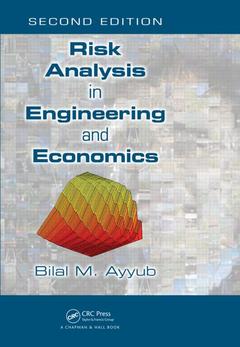Risk Analysis in Engineering and Economics (2nd Ed.)
Auteur : Ayyub Bilal M.

Risk Analysis in Engineering and Economics is required reading for decision making under conditions of uncertainty. The authordescribes the fundamental concepts, techniques, and applications of the subject in a style tailored to meet the needs of students and practitioners of engineering, science, economics, and finance. Drawing on his extensive experience in uncertainty and risk modeling and analysis, the author covers everything from basic theory and key computational algorithms to data needs, sources, and collection. He emphasizes practical use of the methods presented and carefully examines the limitations, advantages, and disadvantages of each to help readers translate the discussed techniques into real-world solutions.
This Second Edition:
- Introduces the topic of risk finance
- Incorporates homeland security applications throughout
- Offers additional material on predictive risk management
- Includes a wealth of new and updated end-of-chapter problems
- Delivers a complementary mix of theoretical background and risk methods
- Brings together engineering and economics on balanced terms to enable appropriate decision making
- Presents performance segregation and aggregation within a risk framework
- Contains contemporary case studies, such as protecting hurricane-prone regions and critical infrastructure
- Provides 320+ tables and figures, over 110 diverse examples, numerous end-of-book references, and a bibliography
Unlike the classical books on reliability and risk management, Risk Analysis in Engineering and Economics, Second Edition relates underlying concepts to everyday applications, ensuring solid understanding and use of the methods of risk analysis.
Introduction. Risk Analysis Methods. System Definition and Structure. Reliability Assessment. Failure Consequences and Severity. Engineering Economics and Finance. Risk Control Methods. Data for Risk Studies. Fundamentals of Probability and Statistics. Failure Data. References and Bibliography. Index.
Bilal M. Ayyub is professor of civil and environmental engineering at University of Maryland, College Park and director of the Center for Technology and Systems Management at A. James Clark School of Engineering. Highly decorated and widely published, he holds degrees from Kuwait University and the Georgia Institute of Technology. A fellow of ASCE, ASME, SRA, and SNAME, as well as a senior member of IEEE, he has completed research and development projects for entities including the National Science Foundation, U.S. Air Force, U.S. Coast Guard, Army Corps of Engineers, Navy, Department of Homeland Security, and private insurance and engineering firms.
Date de parution : 04-2014
17.8x25.4 cm
Thèmes de Risk Analysis in Engineering and Economics :
Mots-clés :
Expert Opinion Elicitation; expert; CS1 CS2 CS3 CS4 CS5; opinion; Cumulative Hazard Rate Function; elicitation; Minimal Cut Sets; cs1; Empirical Survivor Function; cs2; NPV NPV; cs3; Optimal Maintenance Policies; cs4; Posterior PDF; cs5; Contributing Factor Diagram; failure; HRF; consequences; Present Worth Factor; High High High High High; Reliability Function; Cash Flow Diagrams; Compound Amount Factor; Series Parallel System; Efficient Frontier; Hazard Functions; Optimal Maintenance; Basic Random Variables; Bayesian Network; Influence Diagrams; Correlated Random Variables; CS Distribution; Blind Ignorance



